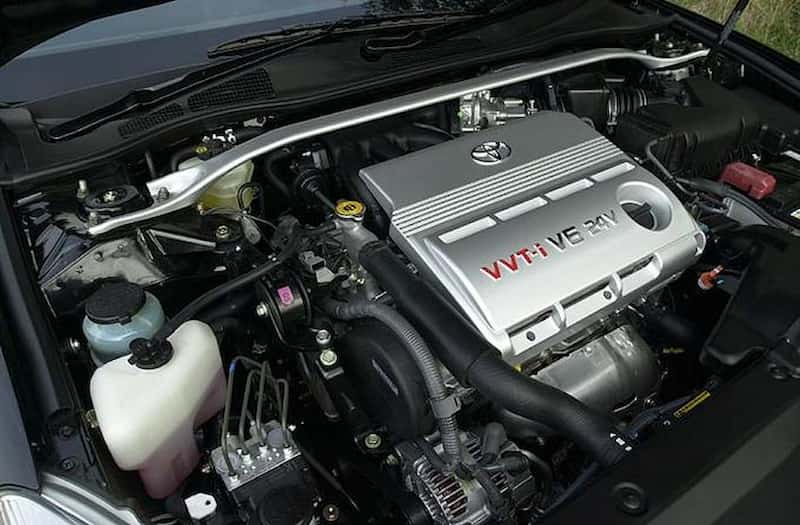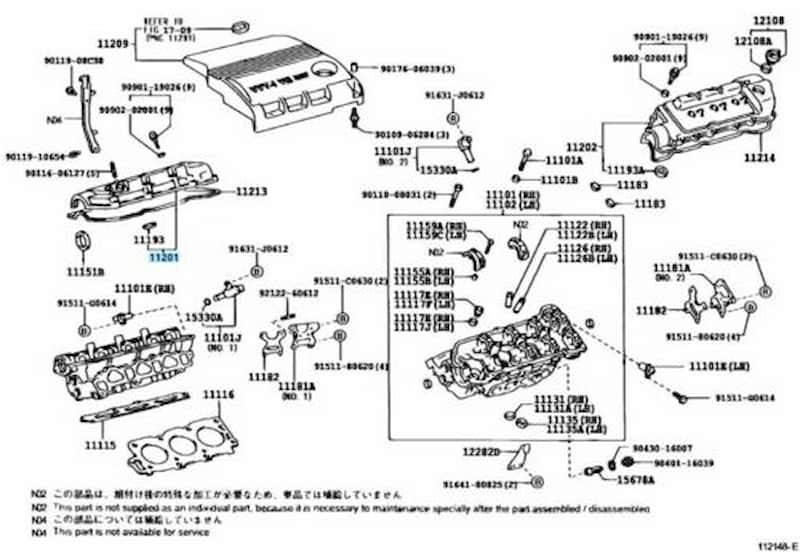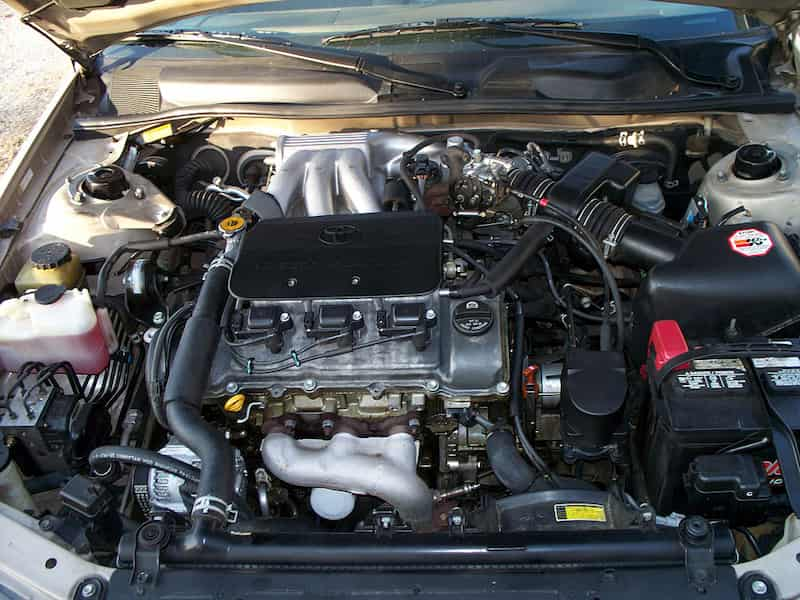Known as one of the engines with incredible reliability and durability, the 1MZ-FE Turbo Engine has always been the foundation for the development of more advanced engines in the future.
This V6 power plant is integrated into popular automobiles and carries great features and potential. What are 1MZ-FE Turbo engine specifications? What are its advantages and disadvantages? You will find useful and detailed information here. Let’s read on.
What Is 1MZ-FE Turbo Engine?

The 1MZ-FE Turbo, or the 3.0-liter 1MZ-FE engine, was designed and produced in 1993 at American and Japanese manufacturing plants. It is manufactured under 2 types of power units: included and excluded VVT-i phase regulator.
Are you wondering what 1MZ-FE stands for? In detail, 1 represents the first generation, and MZ is the engine family. Besides, F indicates the dual overhead cam engines (DOHC) – narrow-angle economy block, and E refers to multi-point fuel injection (MFI).
The purpose of producing this MZ turbo engine was to offer bigger sedans with more power than the VZ that was used before.
In addition to the 1MZ, the 2MZ‑FE and 3MZ‑FE turbo engines were also produced as variants with a larger displacement.
Toyota 1MZ-FE Engine Diagram

What Are 1MZ-FE Turbo Engine Specifications?
| Engine Displacement | 2994cc |
| Engine lifespan | 450.000km |
| Weight | 175kg |
| Cylinder Valves | 24 |
| Fuel system | injector MPI |
| Power output | 168hp – 194hp (excluded VVT-i) 210hp – 220hp (included VVT-i) |
| Torque output | 248Nm – 275Nm (excluded VVT-i) 301Nm – 328Nm (included VVT-i) |
| Cylinder block | Aluminum V6 |
| Blockhead | Aluminum 24v |
| Cylinder bore | 87.5mm |
| Piston stroke | 83mm |
| Integrated parts | Drive-by-wire Electronic throttle control |
| Compression ratio | 10.5 |
| Timing drive | belt |
| Suitable engine oil | 5W-30 |
| Engine oil capacity | 4.7 liter |
| Gasoline type | 92 (excluded VVT-i) 95 (included VVT-i) |
| European emission standards | EURO 2 or 3 (excluded VVT-i) EURO 3 or 4 (included VVT-i) |
Advantages And Disadvantages
Advantages
Lightweight Materials
Most turbo engines (cylinder block, blockhead, rotating) are made of aluminum. It is a soft, light, and heat-resistant metal. It has 3 times better thermal conductivity than iron and steel.
Using this material greatly reduces engine weight, improves performance, and saves drivers considerable money.
Components Integration
Besides, the engine also operates more smoothly thanks to integrating components such as a rotating cluster flat torque band. These built-in parts have helped the machine manage with more power, meeting long trips on the highway.
Another reason that makes the 1MZ-FE turbo one of the most popular Toyota engines is its ability to deliver and distribute power. It can precisely adjust the force required to operate the vehicle to match the driver’s speed.
Disadvantages
Putting aside its amazing abilities, the 1MZ-FE has a few unresolved issues. The overheating problem often appears when the car moves for a long time on high slopes due to excessive fuel combustion. Also, it deposits oil and increases carbon formation due to extreme temperature conditions.
Moreover, knock sensors, valve failure, throttle blockage, and engine freezing in cold weather are often faulty, so you may have to replace them often.
However, some of the above errors do not affect their driving process much for some drivers, so don’t change it if you don’t think it’s necessary.
Tuning Up The Toyota 1MZ-FE Engine

Accelerate Power
The easiest power modification you can make toward the 1MZ FE may be a fast road cam, which can increase voltage rating by an additional 10-15% based on the profile. The input and emissions system should be modified afterward.
If the issue of delivering cold air to extensively adjusted power plants and turbocharged cars is resolved, the induction kit will assist in unleashing the force. With exhaust systems, the airflow of the power plant is balanced.
However, if the exhaust pipe is large (its diameter is wider than 2.5 inches), you may waste a lot of flow rate, reducing your engine’s torque and horsepower. Some commercial gas going through the skull can significantly improve circulation.
They must coordinate and be built up to prepare for additional engine modifications. The horsepower will be kept moving in the right direction with the aid of a durable material that improves the fast road clutch.
It would help if you don’t cut corners or believe your OEM (Original Equipment Manufacturer) clutch will suffice. The finest modifications for a 1MZ FE include induction upgrades, sporty camshafts, and remaps.
Install Forced Induction
The basic engine’s maximum power increase is between 5 and 6 psi. When you tune it right with a piggy ECU, you may hit roughly (200-240bhp) at a pressure of 220-260bhp.
5.5 psi could provide around 190 kW of power, but standard fueling cannot handle it. It will help if you use bigger injectors, a piggy ECU, and a fuel pump.
The basic cylinder is capable of handling 10psi. However, you’ll have made several modifications to the powertrain, and it’d be unwise not to have previously installed tougher pistons, strengthened crankshaft, and tie rods, and altered the pressure ratio.
You need to equip an intercooler to lower the excessive intake heat that occurs with forged pistons, such as a turbocharger. Remember that 1MZ FE vehicles are all front-wheel driven, and handling problems occur above 200 horsepower.
FAQs
Which Cars Have The 1MZ-FE Engine?
This type of engine is not only used on Toyota sedans but also equipped in Lexus cars.
For both excluded and included VVT-i models, the turbo engine is available on Toyota models manufactured in the years 1993 to 2008, such as:
Camry (1993-2002), Windom (1993-2003), Avalon (1994-2004), Sienna (1997-2002), Mark II Wagon (1997-2001), Solara (1998-2003), Pronard (2000), Estima (2000-2005), Avalon (2000-2004), Highlander/Kluger (2000-2003) ), Camry (2003-2006), Alphard (2002-2008), and Harrier.
You must have heard of the Toyota 1MZ-FE Turbo Celica. The Celica was one of the popular models of the 2000s even though it is now out of production.
The engine also appears in the Lexus models, including the Lexus ES 300, Lexus RX 300 (1998-2003), and Lexus ES 300 (1999-2003) and in older cars, you also need to check if Toyota Navigation App Not Installed ?
What Are The Common Problems And How To Fix Them?
One of the problems that engines in general and 1MZ-FE in particular often face is sludge stuck in the engine after a long operation.
It results from leaving the turbo in and not cleaning it for a long time. It can lead to other issues, such as the engine will easily overheat because these mud layers will hold the heat.
Besides the 1MZ-FE exhaust faulty, mud and oil build-up in the engine and intake manifolds can cause engine components to no longer function as smoothly as before. Lubricating fluid will deposit on the oil tank cap and make the engine less efficient.
The only way to solve this problem is to service and change the engine oil regularly. 1MZ-FE tuning is not an easy thing. You should take your car to local garages and car dealers to help clean and change the oil.
How To Distinguish 1MZ-FE From 2MZ-FE And 3MZ-FE?
The Toyota 2MZ-FE retains some of the characteristics of the 1MZ-FE, such as its diameter and lightweight materials. However, there are a few innovative additions to this model.
The first improvement is that the displacement of the 2MZ-FE is smaller than the 1MZ-FE (2,494cc). In addition, the piston stroke is reduced from 83mm to 69.2mm. The capacity is also cut down by 0.5L. This engine is used in Toyota models such as the Camry, Windom, and Mark II Qualis.
The Toyota 3MZ-FE retains all the characteristics of the 1MZ-FE. The most noticeable difference is the significantly improved knock sensor. Its durability is also better, so you can spot problems accurately.
Although the displacement of the third gen is the same as the 1MZ-FE, the bore is larger (92mm)m, resulting in an increase in its capacity by 0.3L.
Conclusion
Toyota 1MZ-FE Turbo Kit is an advanced engine line to replace the VZ series. Its highlight is that it is made of light alloy material and can deliver and distribute power well. However, oil deposits and carbon formation might appear due to extreme temperature conditions.
In addition to the 1MZ-FE, variants like 2MZ-FE and 3MZ-FE are produced, which are upgraded versions that simplify some characteristics and have larger capacities.
We hope this article has provided the necessary information for your child. See you in the next posts!
